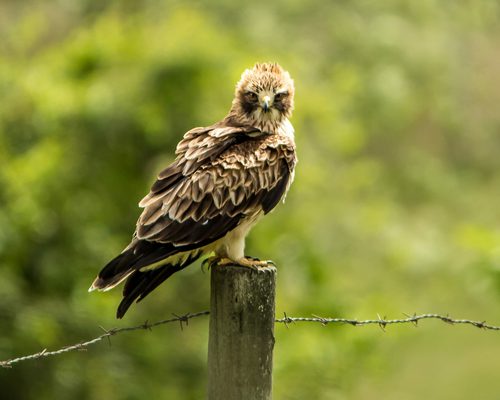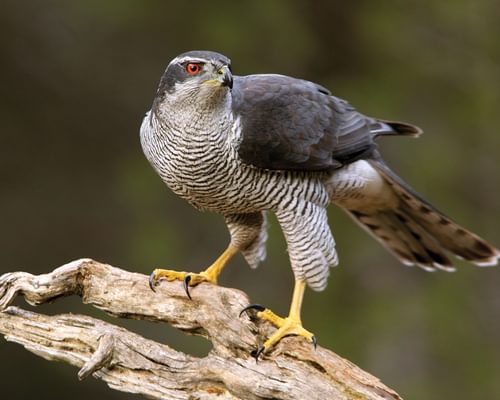Bonelli's Eagle
Least ConcernAquila fasciata
Visual Identification
Appearance
The Bonelli's Eagle is a large, powerful raptor with a distinctive appearance. Adults display dark brown upperparts contrasting with a white underside, often streaked with black. The long, broad wings and barred tail are characteristic features, while the head shows a pale throat and dark 'moustache' markings.
Females are noticeably larger than males but share similar plumage. Juveniles have rufous-brown upperparts and buff underparts, gradually acquiring adult plumage over several years.
Size
Length
65cm to 72cm
Wingspan
150cm to 180cm
Weight
1.6kg to 2.4kg
Colours
Males and females have similar plumage
Primary Colour
Brown White
Secondary Colour
Black Grey
Beak Colour
Grey
Leg Colour
Yellow
Habitat and Distribution
Habitats
Woodland
Garden
Wetland
Coastal
Urban
Farmland
Grassland
Desert
Tundra
Rainforest
Mountain
Savanna
Distribution
Bonelli's Eagles inhabit a range of open to semi-open landscapes, from Mediterranean coastal areas to arid mountain ranges. They prefer rugged, rocky terrain with cliffs for nesting, interspersed with woodland and open areas for hunting.
Their distribution spans from southern Europe and North Africa, across the Middle East, to parts of South and Southeast Asia. In Europe, they are most common in Spain and Portugal, with smaller populations in southern France and Italy.
Elevation Range
Sea level to 3,000 meters
Climate zones
Mediterranean, Subtropical, Tropical
Distribution Map
This map gives you a rough idea of where you might spot a Bonelli's Eagle. The coloured areas show countries where these birds have been seen.
A few things to keep in mind:
- Birds might not be everywhere in the coloured areas, for example, they may be present around the coast of that country
- Where birds live can change with seasons and available food
- This map is quite simple - it doesn't show exact locations
We're working on making our maps even better! Soon, we hope to show you:
- More detailed maps for bigger countries, including state and region
- How birds move around during different seasons
Distribution by Region
Behaviour and Ecology
Bird Attributes
This feature is in beta. We'd love your feedback to improve it!
Share your thoughtsBird Attributes Explained
Our bird attributes system rates various aspects of a bird's capabilities on a scale of 0-100, based on data from field observations, scientific studies, and expert knowledge.
Attribute Categories:
- Agility: Manoeuvrability, speed, and grace in flight or movement.
- Strength: Physical power, often correlating with size and hunting abilities.
- Adaptability: Ability to thrive in various environments or changing conditions.
- Aggressiveness: Territorial behaviour and assertiveness, particularly during breeding seasons.
- Endurance: Stamina, often seen in migration patterns or foraging behaviours.
Understanding the Ratings:
- 0-20: Very Low
- 21-40: Low
- 41-60: Average
- 61-80: High
- 81-100: Very High
Remember, these attributes are relative to other bird species and don't necessarily indicate superiority.
Hover over the icon next to each attribute for more information.
Tap the icon next to each attribute for more information.
Agility
Reflects the bird's manoeuvrability, speed, and grace in flight or movement.
The Bonelli's Eagle demonstrates remarkable agility, performing spectacular aerial displays including steep dives and loop-the-loops during courtship. Their ability to manoeuvre swiftly in varied terrains, from coastal areas to mountainous regions, showcases their exceptional aerial prowess.
Strength
Indicates the bird's physical power, often correlating with size and hunting abilities.
As a large raptor with a powerful build, the Bonelli's Eagle possesses considerable strength. Their ability to carry medium-sized prey such as rabbits and partridges, coupled with their impressive wingspan of up to 180 cm, indicates robust physical power.
Adaptability
Represents the bird's ability to thrive in various environments or changing conditions.
These eagles exhibit notable adaptability, thriving in diverse habitats from sea level to 3000 metres elevation. Their versatile diet and ability to hunt in various landscapes, from open areas to woodlands, demonstrate their adaptive nature.
Aggressiveness
Measures the bird's territorial behaviour and assertiveness, particularly during breeding seasons.
Bonelli's Eagles display moderate to high aggressiveness, particularly in territorial defence and hunting. Their cooperative hunting strategy and willingness to tackle a variety of prey, including agile birds and mammals, indicate a assertive predatory nature.
Endurance
Reflects the bird's stamina, often seen in migration patterns or foraging behaviours.
With their ability to soar for extended periods and perform energy-intensive aerial displays, Bonelli's Eagles show high endurance. Their partial migratory behaviour and capacity to inhabit challenging environments from Mediterranean coastal areas to arid mountain ranges further attest to their stamina.
Diet
Bonelli's Eagles are versatile predators, primarily hunting medium-sized birds and mammals. Their diet includes partridges, pigeons, rabbits, and hares. They also opportunistically take reptiles and occasionally fish.
These eagles employ a combination of soaring searches and surprise attacks from perches to capture prey.
Behaviour
Bonelli's Eagles are known for their spectacular aerial displays during courtship, performing steep dives and loop-the-loops. They are territorial birds, often seen soaring high over their domain with slow, powerful wingbeats.
These eagles hunt cooperatively in pairs, demonstrating remarkable coordination when pursuing agile prey.
Vocalisation
Bonelli's Eagles are generally quiet outside the breeding season. During courtship and territorial displays, they emit a series of sharp, barking 'klu-klu-klu' or 'klee-klee-klee' calls. These vocalisations are often accompanied by impressive aerial manoeuvres, adding to their dramatic presence.
Nesting & Breeding
Bonelli's Eagles form monogamous pairs, often mating for life. The breeding season typically begins in January or February, with elaborate aerial displays marking courtship.
Nests are large stick structures, usually built on cliff ledges or occasionally in large trees. The female lays 1-3 eggs, typically 2, which are white with reddish-brown spots.
Incubation lasts about 39 days, and it is shared by both parents but primarily done by the female. Chicks fledge after 60-65 days but remain dependent on their parents for several more months.
Lifespan
The Bonelli's Eagle typically lives for 15 years, with a maximum recorded lifespan of 20 years.
Like all birds, lifespan can be affected by factors including predation, habitat quality, disease, and access to food sources.
Conservation and Status
Global Conservation Status
While listed as Least Concern globally, Bonelli's Eagle faces regional threats. Habitat loss, electrocution from power lines, and illegal shooting are primary concerns.
Conservation efforts focus on habitat protection, nest site management, and reducing human-wildlife conflicts.
Birdwatching Tips
- Look for them soaring over mountainous or hilly terrain
- Listen for their distinctive 'klu-klu-klu' call during breeding season
- Observe cliff faces or large trees for potential nesting sites
- Visit Mediterranean coastal areas or inland mountain ranges for better chances of sighting
Additional Information
Quick Facts
Other names:
Bonelli's Hawk-eagle
Family:
AccipitridaePredators
Did You Know?
- Bonelli's Eagles can fly at speeds of up to 80 km/h when diving for prey.
- They have been known to use the same nesting site for over 20 years.
- These eagles play a crucial role in controlling populations of rabbits and partridges in their ecosystems.
Was this bird profile helpful?
Your feedback helps us improve our content
Thanks for your feedback!
Your input helps us improve our content.
Community Experience
Community Ratings
No ratings yet - be the first to rate this bird!
Latest Community Reviews
No reviews yet
Sign in to be the first to review
Community Reviews
Create Your Free Account Welcome Back!
Join our community to rate birds and share your experiences. Creating an account is completely free and only takes a minute. Sign in to your account to rate birds and share your experiences with our community.
Your information is secure and will never be shared.
By creating an account, you agree to our Privacy Policy.
Similar Birds
References
- 2 3 4
website: BirdLife International. 2019. Aquila fasciata (amended version of 2016 assessment). The IUCN Red List of Threatened Species 2019: e.T22696076A155464015.
View source - 1
website, 2000: Carey and Judge, Longevity Records: Life Spans of Mammals, Birds, Amphibians, Reptiles, and Fish
View source

